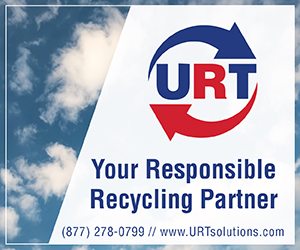Blue-Pencil Mobile Shredding of Oakville, Ontario; Confidential On-Site Paper Shredding (COPS) of Normal, Ill.; Goodwill Southern California Secure Shredding of Los Angeles; Infoshred of East Windsor, Conn.; Ingram Micro of Pine Brook, N.J.; Secure Document Solutions of Independence, Mo.; Stevens & Stevens Business Records Mgmt of Clearwater, Fla. and Vanish Document Shredding of Houston have either achieved or renewed their NAID certifications for physical destruction of hard drives.
Visit our archive to view previous editions of the scorecard.




 Former employees of E-Waste Systems have yet to be paid over $240,000 in court-ordered compensation. Meanwhile, the U.S. Securities and Exchange Commission recently took action against the short-lived publicly traded company.
Former employees of E-Waste Systems have yet to be paid over $240,000 in court-ordered compensation. Meanwhile, the U.S. Securities and Exchange Commission recently took action against the short-lived publicly traded company.
 E-Scrap News readers in September were overwhelmingly drawn to coverage of a lawsuit targeting Closed Loop Refining and Recovery and two of its CRT material suppliers.
E-Scrap News readers in September were overwhelmingly drawn to coverage of a lawsuit targeting Closed Loop Refining and Recovery and two of its CRT material suppliers. A modular phone maker receives significant new capital, and an investment manager advises shareholders to push companies away from exporting e-scrap.
A modular phone maker receives significant new capital, and an investment manager advises shareholders to push companies away from exporting e-scrap.


 A second e-scrap company has been released from an Arizona CRT abandonment lawsuit targeting upstream suppliers of the material.
A second e-scrap company has been released from an Arizona CRT abandonment lawsuit targeting upstream suppliers of the material. Future funding levels for the U.S. EPA are one step closer to certainty after lawmakers in the U.S. House of Representatives approved government spending outlined in a dozen agency-specific budget bills this month.
Future funding levels for the U.S. EPA are one step closer to certainty after lawmakers in the U.S. House of Representatives approved government spending outlined in a dozen agency-specific budget bills this month. Last Tuesday and Wednesday, dozens of industry experts took to the stage in Orlando to discuss the trends and challenges shaping electronics recovery right now. Here are some of the most compelling pieces of information we took away from those talks.
Last Tuesday and Wednesday, dozens of industry experts took to the stage in Orlando to discuss the trends and challenges shaping electronics recovery right now. Here are some of the most compelling pieces of information we took away from those talks.